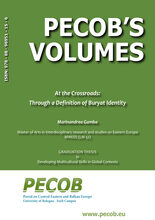and Balkan Europe
by IECOB & AIS Università di Bologna

This area collects and offers a wide range of scientific contributions and provides scholars, researchers and specialists with publishing opportunities for their research results
At the Crossroads: Through a Definition of Buryat Identity
by: Marinandrea Gamba

Abstract
The deep integration of Buryat people in the territory of the Russian Federation and their peaceful national revival was a surprise for its multicultural character in a country where ethnic conflicts are on the agenda. The matter of concern regards the historical reasons of their inter-cultural approach and the possibilities these people have been able to seize in order to assimilate into the multi-ethnic Russian society without precluding themselves the chance for a cultural renaissance. The thesis explores the vast world of Buryats throughout their history from their origins as an ethnic group up to present day in the Republic of Buryatia and in the big metropolitan city of St. Petersburg.
The goal of this enquiry is to demonstrate, how over time Buryats have been able to absorb and independently work out cultural traits from peoples with whom they have come into contact, thereby defining their own cross-cultural identity.
Analysis has taken place through a historical point of view by considering each step taken by the Buryat people in the formulation of their identity as a group and afterwards the enquiry took on a more sociological character by looking carefully to the contemporary results of their multicultural interaction and their efforts of identity-keeping in the diaspora.
The study has revealed how the multicultural territory where Buryats originally lived was decisive for the formation of intercultural identities, strongly unified among them by a feeling of belonging to the same natural and social tradition. The advent of Buddhism brought an even further inter-ethnic approach to Buryat culture, since it came to encompass and assimilate Buryat specificities into a more cosmopolitan horizon. Its basic principle of non-violence and its history of intercultural development laid the foundations of Buryat contemporary renaissance as people of multicultural origins grouped around a Buddhist tradition of opening and assimilation, but also as people with a strong sense of cultural affiliation.
Table of contents
Acknowledgements
Abstract
Introduction
1. Who were the Buryats?
1.1 Between tradition and an inter-cultural territory
1.2 A cosmopolitan creed
1.3 Ecology as identity
1.4 Shamanism and ecology
1.5 Buddhism and ecology
1.6 First attempts of cohabitation: buryats and russians
1.7 The revolution and the Soviet time
2. Post-Soviet Buryatia and the revival of Buryat identity
2.1 An hybrid intelligentsia heritage
2.1 An ethnic revival within a multicultural heritage
3. The diaspora in St. Petersburg
3.1 The need for a temple
3.2 An intercultural and challenging enviroment
3.3 “AYA-GANGA” (‘АЯ-ГАНГА’)
3.4 The Buryat community at the temple
Conclusion
Bibliography
(English literature)
(Russian literature)
Interviews
TV Programs
Annexes


 Download the full Volume
Download the full Volume





